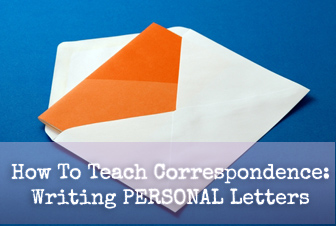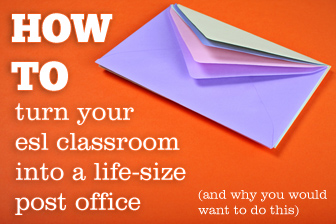How to Teach Correspondence to Your ESL Students: Writing Personal Letters


If you answered yes to either of these questions then turning your classroom into a life-size post office may be the perfect solution for you and your students. It is fun, engaging and gets them writing without them even realizing it. Read on to find great ways to do it.
P.O. Box Box
You will want to start this classroom transformation by assigning each student a mailbox. You will have a choice to make from the beginning, and it will probably be influenced by your classroom space. Will you need to stack mailboxes, or do you have room to lay them out in one layer? If you need to stack them, you may need to purchase boxes or collect them yourself to make sure they are uniform in size and shape. If you have more space, you can have each student bring in his own box (a shoe box is a good size) since they will not have to stack together. If you are responsible for art classes, too, you can use that period to decorate and design the P. O. Boxes. Each box should be securely closed with the front panel able to open. Do this by cutting the bottom and both sides parallel to the end of the box. Keep the top intact so the mailbox will close with a flap front. Most likely, you will have to cut the boxes yourself since an Exacto or box cutter will be easiest to use. Make sure you do this the day before the kids decorate their boxes. Then on the day the students will decorate, make available to them paints, markers, glitter and any other art supplies you have hanging around your classroom. This is a great way to use up leftover odds and ends from other projects. Also, keep in mind that if you are stacking the boxes, you will want to encourage your students to decorate the front of the box because other boxes will be stacked next to and on top of their box. If you are not going to stack the boxes, have your students decorate the entire box. You can also modify how it opens if you won’t be stacking by cutting a slot into a removable lid and then accessing the mail by removing the lid and then replacing it.
Many teachers do this kind of activity around Valentine’s Day, but there is no need to wait until then to get your students writing. The mailboxes will be even better and useful for a longer period of time if they are not decorated with only hearts and red paper. If you do this activity early in the year, the boxes will be available for valentines when the time comes. You can also use your school’s colors to decorate the boxes if you want some uniformity among the boxes, but mostly let your students use this opportunity to make their boxes their own, to show their personalities and to feel like they have a permanent place in their own classroom.
You will also need a collection of envelopes for your students to use when they are writing their classmates. Ask your students to bring in envelopes from home whenever they have them, and let your fellow teachers also know that you are collecting envelopes. Most people will have a collection of mismatched envelopes and cards (you can have them donate the cards, too, if you like) that they are all too willing to get rid of for a good cause. You could also include a box of envelopes on your beginning of the year supplies list for each student. Your class will likely go through envelopes rather quickly, so be on the lookout for scrap or recycled envelopes throughout the year.
Write On
During writing workshops, allow students to work on pieces they are writing for other subjects, but give them the option of writing letters to one another as well. This will break up the potential monotony of writing classes, and they will not even realize they are practicing their writing. These letters are not going to be the time or the place for grammar grades. Think of them more as free writing, encouraging your students to write about their thoughts and feelings without fear of repercussion. Though there may be grammatical errors, there is value in the writing itself, and many of the grammatical issues will work themselves out when your students get feedback from other, formal writing assignments.Having a classroom post office also gives you, the teacher, the opportunity to recognize your students in special ways. When one of your students has done particularly excellent work, drop her a note in her mailbox. Be warned that you may find some popularity issues cropping up among students if some of them do not get mail on a regular basis. Nip this in the bud by periodically assigning specific topics to specific occasions and students. Your students can write their letters “to whom it may concern” and then you can distribute accordingly. You can even give your students a chance to respond to what the first student has written in a letter of his own. Then review with your students how to address an envelope (you can be as informal as writing a first name and a box number or as formal as full name, P.O. Box, and the address of the school) and have them drop their letters into a classroom mail box. You can use a decorated waste paper basket or other container for this.
Speedy Delivery
Each day, give one student the task of delivering the mail. This is great to add to a responsibility chart if you keep one on a regular basis. You will most likely want to do deliveries at the beginning of the day. The assigned mail carrier for the day should read the student’s name and mail box number from the envelope and then deliver it to the right P.O. Box. You can let students collect their mail at that point or wait until later in the day when they have free time. You will be less likely to have popularity issues if you make your students wait until lunch or a free period before checking the mail. Each student should understand, though, that it is his or her responsibility to check the mail every day. In this way, your students are not only increasing their reading and writing skills, they are also learning life skills and responsibility.
A Formal Event
Take the classroom post office a step further by teaching your students how to write letters. Make sure they understand words like addressee, address, return address, date, signature, greeting, closing and any other parts of a letter you want to cover. You can take one day to explain how to write personal letters and another for business letters (if your students are old enough to distinguish between the two). Most of the information required for each type of letter is the same, but the format is slightly different. And of course, the writer’s voice is different in the two. If you are teaching voice to your students here is a great place to practice it.
A little forethought will go a long way, and your students will reap the benefits all year. It is never too late for a mail call, so try it out with your students today!